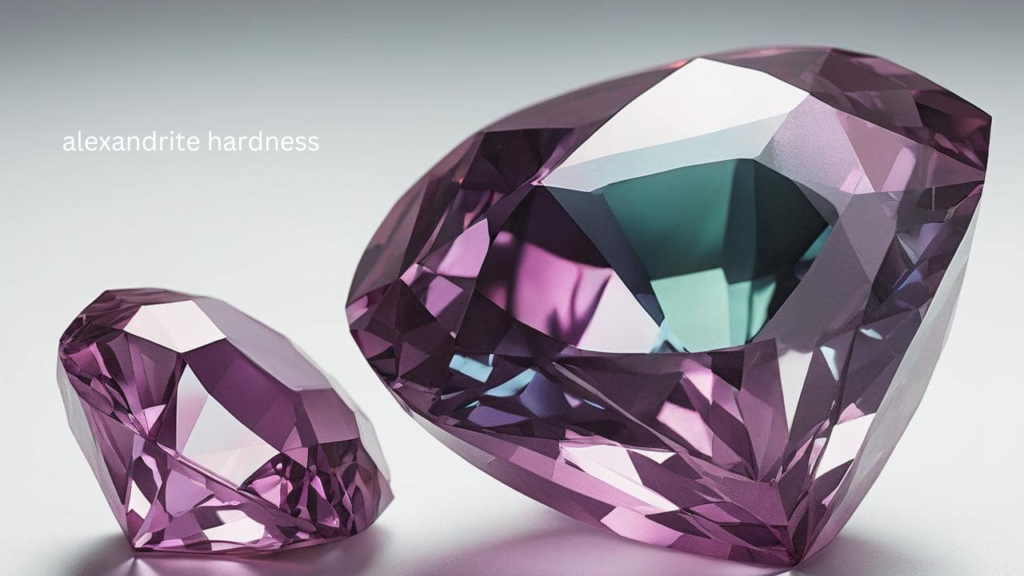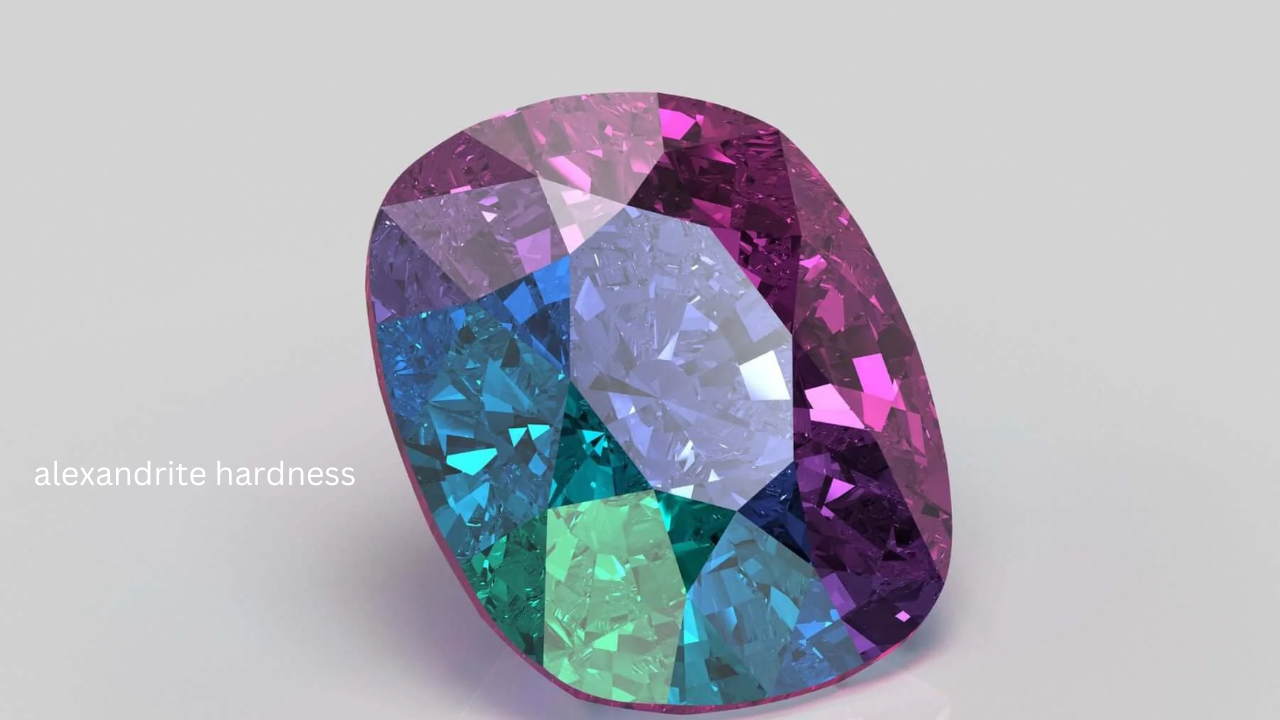Alexandrite hardness one of the most captivating and rare gemstones in the world. Known for its striking color-changing properties, it has become a favorite among gem enthusiasts and collectors. However, like any precious gemstone, Alexandrite hardness care to maintain its beauty and durability. Understanding the hardness of Alexandrite is crucial to ensuring its longevity, especially if you are considering incorporating it into fine jewelry. In this article, we will delve deep into the topic of Alexandrite hardness, its significance, and essential care and maintenance tips to keep your Alexandrite jewelry in pristine condition.
What is Alexandrite?
Before diving into Alexandrite’s hardness, it’s important to understand what makes this gemstone unique. Alexandrite is a variety of the mineral chrysoberyl, best known for its remarkable ability to change color under different lighting conditions. This feature, known as the “Alexandrite effect,” is what sets it apart from other gemstones. Under daylight or fluorescent light, Alexandrite typically appears green or blue-green, while it transforms into shades of red or purplish-red under incandescent or candlelight.
This color-changing property is a result of the mineral’s crystal structure and its ability to absorb light differently based on the type of lighting it is exposed to. Alexandrite is highly valued for both its rarity and its visual appeal, making it a highly sought-after gemstone for fine jewelry, particularly rings and earrings.
Alexandrite Hardness: A Measure of Durability

The hardness of a gemstone is an important factor in determining its durability and suitability for various types of jewelry. The Mohs scale of mineral hardness is used to measure the hardness of gemstones and minerals. The scale ranges from 1 to 10, with 1 being the softest (like talc) and 10 being the hardest (like diamond).
Alexandrite has a hardness of 8.5 on the Mohs scale. This places it in the “hard” category, meaning it is relatively resistant to scratches and wear compared to softer gemstones like pearls or opals. However, it is not as hard as diamonds, which have a hardness of 10. This is an important consideration when determining how to care for and maintain your Alexandrite jewelry.
Why is Alexandrite Hardness Important?
- Scratch Resistance: A hardness of 8.5 means that Alexandrite is resistant to scratches, but it is not impervious. While it will withstand daily wear better than softer stones, it can still be scratched by harder materials, such as diamonds or sapphires. It is important to avoid wearing Alexandrite jewelry when engaging in activities that may expose it to harsh conditions, such as sports or heavy labor.
- Durability: Alexandrite’s relatively high hardness ensures that it will maintain its luster and smooth surface over time. However, it is still susceptible to damage from impacts or sharp blows. Unlike softer stones that can easily be scratched or chipped, Alexandrite can maintain its integrity when properly cared for.
- Value Retention: The hardness of Alexandrite also plays a role in maintaining its value. A well-maintained Alexandrite gemstone will retain its visual appeal and continue to shine brilliantly for years, making it a sound investment for those looking to pass down their jewelry as heirlooms.
Care and Maintenance Tips for Alexandrite Jewelry
Cleaning Your Alexandrite Jewelry
Proper cleaning is essential to preserving the beauty and durability of your Alexandrite jewelry. Over time, dust, dirt, and oils from your skin can accumulate on the surface, dulling the gemstone’s shine.
- Use Mild Soap and Water: The safest way to clean Alexandrite is to use warm water mixed with a small amount of mild dish soap. Soak the jewelry in the solution for a few minutes and gently scrub it with a soft toothbrush. Avoid using harsh chemicals or cleaners, as they can damage the gemstone or the metal setting.
- Rinse and Dry Carefully: After cleaning, rinse the jewelry thoroughly with clean water to remove any soap residue. Dry it with a soft, lint-free cloth. Avoid using paper towels or rough fabrics that could scratch the surface of the gemstone.
- Ultrasonic Cleaners: While ultrasonic cleaners are often used to clean other gemstones, it is advisable to avoid using them for Alexandrite jewelry. The vibrations from the cleaner may cause damage to the gemstone, especially if there are any internal flaws or inclusions.
Storing Alexandrite Jewelry
When not wearing your Alexandrite jewelry, proper storage is essential to prevent damage. While Alexandrite is relatively hard, it can still be scratched by harder gemstones or metals.
- Keep Jewelry Separate: Store your Alexandrite jewelry separately from other pieces, especially those made from harder materials like diamonds, sapphires, or rubies. Consider using individual pouches or compartments in a jewelry box.
- Avoid Extreme Temperatures: Alexandrite should be kept away from extreme heat or cold, as drastic temperature changes can cause thermal shock, which could lead to cracks or fractures.
- Use a Soft Lining: If you’re storing your Alexandrite jewelry in a box, make sure the interior is lined with a soft material such as velvet or fabric to prevent scratches.
Protecting Alexandrite from Chemicals
Although Alexandrite is a durable gemstone, it can still be affected by exposure to chemicals. Everyday household products like lotions, perfumes, and cleaning agents can cause a buildup of residue on the surface of the gemstone, affecting its shine.
- Remove Jewelry Before Using Chemicals: To prevent damage, always remove your Alexandrite jewelry before applying makeup, perfumes, or cleaning products. Chemicals in these items can cause the gemstone to become dull or lose its brilliance over time.
- Avoid Chlorine: Exposure to chlorine, such as in swimming pools or hot tubs, can damage both the gemstone and the metal setting. Make sure to take off your Alexandrite jewelry before swimming.
Regular Inspections
As with any precious gemstone, regular inspections are essential to ensure the longevity of your Alexandrite jewelry.
- Check for Loose Stones: Periodically check the setting of your Alexandrite jewelry to ensure the stone is secure. If the setting becomes loose or the gemstone shifts, take the jewelry to a professional jeweler for repairs.
- Inspect for Scratches and Chips: Although Alexandrite is durable, it can still develop surface scratches or chips over time. Regular inspections can help you spot any damage early, allowing for repairs before the damage becomes severe.
Professional Care
For the best results, consider having your Alexandrite jewelry professionally cleaned and inspected at least once a year. Professional jewelers have the tools and expertise to clean and care for gemstones safely, and they can also spot any potential issues that may require attention.
Alexandrite Hardness Compared to Other Gemstones
While Alexandrite has a hardness of 8.5, it is important to compare this to other popular gemstones to understand its relative durability:
- Diamonds (10): The hardest known natural material, diamonds are incredibly durable and resistant to scratches and damage.
- Sapphires and Rubies (9): These gemstones are extremely hard and can withstand significant wear and tear, making them ideal for everyday jewelry.
- Emeralds (7.5 – 8): While emeralds are prized for their rich green color, they are relatively softer than Alexandrite and are more susceptible to scratching.
- Opals (5.5 – 6.5): Opals are much softer than Alexandrite and can easily be scratched or damaged.
Understanding the hardness of different gemstones allows you to make informed decisions about the type of jewelry you choose and how to properly care for it.
Conclusion
Alexandrite is a stunning and rare gemstone that deserves special attention to maintain its beauty and value. Its hardness of 8.5 on the Mohs scale means it is relatively durable and resistant to scratches, but it still requires proper care to ensure its longevity. By following the cleaning, storage, and maintenance tips outlined in this article, you can preserve the brilliance of your Alexandrite jewelry for years to come. Remember to handle your Alexandrite with care, avoid exposing it to harsh chemicals, and have it professionally inspected regularly to keep it in optimal condition.
Frequently Asked Questions (FAQs)
Is Alexandrite a durable gemstone?
Yes, Alexandrite is relatively durable with a hardness of 8.5 on the Mohs scale, making it resistant to scratches. However, it is not as hard as diamonds, so care should still be taken to avoid rough impacts.
How can I clean my Alexandrite jewelry?
The best way to clean Alexandrite jewelry is by using mild soap and warm water. Gently scrub it with a soft toothbrush, rinse thoroughly, and dry with a soft cloth. Avoid ultrasonic cleaners.
Can Alexandrite be damaged by chemicals?
Yes, exposure to chemicals such as perfumes, lotions, and cleaning agents can dull the surface of Alexandrite. It is recommended to remove your jewelry before using such products.
How should I store Alexandrite jewelry?
Store Alexandrite jewelry in a soft-lined box or individual pouch, away from other harder gemstones like diamonds. Avoid exposing it to extreme temperatures or harsh environments.
Does Alexandrite require professional maintenance?
It is a good idea to have your Alexandrite jewelry professionally cleaned and inspected at least once a year. A jeweler can help ensure that the gemstone is secure and free of damage.
You May Also Read: https://techworknews.com/vegamovies/

